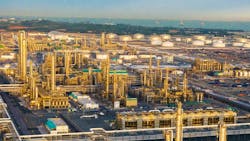Eni-Petronas-Euglena JV lets major contract for Malaysian SAF, HVO project
Eni SPA’s Enilive SPA alongside partners Petroliam Nasional Berhad’s (Petronas) Petronas Mobility Lestari Sdn. Bhd. (PMLSB) and Euglena Co. Ltd. of Japan have enlisted Samsung E&A Co. Ltd. to serve as main contractor for the joint venture’s previously announced proposal to build a biorefinery in the Pengerang Integrated Complex (PIC) at Johor in southern Peninsular Malaysia (OGJ Online, July 26, 2024; Apr. 3, 2023).
As part of a letter of award (LOA) issued on Dec. 12, Samsung E&A will provide engineering, procurement, construction, and commissioning (EPCC) work for the planned grassroots biorefinery that will have a flexible configuration to produce sustainable aviation fuel (SAF), hydrotreated vegetable oil (HVO, or renewable diesel), and bionaphtha to meet rising demand for reduced-carbon fuels from global aviation and transportation customers, the service provider said.
The preliminary LOA is scheduled to be signed as official EPCC contract valued at $955 million by the end of January 2025, Samsung E&A said.
Approved for final investment decision in July and most recently targeted for startup in second-half 2028, the planned biorefinery—to be built within Petronas’ existing 300,000-b/d integrated conventional refinery and petrochemical complex—will be equipped with the Eni-Honeywell UOP LLC codeveloped proprietary Ecofining technology for flexible processing of about 650,000 tonnes/year (tpy) of 100% waste and residue biofeedstocks including vegetable oils, animal fats, and waste from the processing of vegetable oils.
With PMLSB and Enilive as its largest shareholders, the JV previously confirmed it is exploring other potential biomass feedstocks such as microalgae oils, with Euglena confirming it will expedite its microalgae research and development activities for supplying algae oil to the global market in line with the project.
Designed to maximize production of SAF and HVO, the new biorefinery also will feature a pretreatment unit for its biofeedstocks, which can be sourced from nearby and abroad given the project’s proximity and access to major international shipping lanes, according to the JV.
The partners previously said the biorefinery would have a combined production capacity for SAF, HVO, and bionaphtha of 12,500 b/d (OGJ Online, Nov. 6, 2023).
The proposed biorefiney—which will be Samsung E&A’s first project in the SAF space—comes as part of the broader global effort to reduce carbon emissions, in line with major countries’ implementation of regulations to increase supply and adoption of SAF, the service provider said.
Alongside the European Union’s mandate requiring at least 2% SAF in aviation fuel from 2025 onwards, Samsung E&A noted Singapore’s introduction of a 1% or higher SAF-blending requirement by 2026, as well as South Korea’s plans to introduce mandatory SAF blending from 2027.
“Disappointingly slow growth in SAF production”
Award of this latest EPCC contract for an SAF project follows a Dec. 10 release of new estimates for SAF production from the International Air Transport Association (IATA)— which represents about 340 airlines comprising over 80% of global air traffic—showing that SAF production volumes in 2024 reached 1 million tpy (double the 500,000 tonnes produced in 2023), with SAF accounting for 0.3% of global jet fuel production and 11% of global renewable fuel.
“This is significantly below previous estimates that projected SAF production in 2024 at 1.5 million tonnes, as key SAF production facilities in the US have pushed back their production ramp up to first-half 2025,” the association said.
In 2025, IATA estimates SAF production will reach 2.1 million tonnes, or 0.7% of total jet fuel production and 13% of global renewable fuel capacity.
IATA said the jump in SAF’s considerably higher percentage share of renewable fuel capacity in 2024 compared to 2023—which resulted from the association’s stricter inclusion criteria that included only projects with current or announced future SAF capability and reduced the total number of projects considered—does not necessarily mean that renewable fuel projects are shifting towards more SAF but rather is due to a smaller overall base of global renewable fuel projects.
“SAF volumes are increasing, but disappointingly slowly. Governments are sending mixed signals to oil companies which continue to receive subsidies for their exploration and production of fossil oil and gas. And investors in new generation fuel producers seem to be waiting for guarantees of easy money before going full throttle,” said Willie Walsh, IATA’s director general.
“With airlines, the core of the value chain, earning just a 3.6% net margin, profitability expectations for SAF investors need to be slow and steady, not fast and furious. But make no mistake that airlines are eager to buy SAF and there is money to be made by investors and companies who see the long-term future of decarbonization. Governments can accelerate progress by winding down fossil fuel production subsidies and replacing them with strategic production incentives and clear policies supporting a future built on renewable energies, including SAF,” Walsh said.
To reach net-zero carbon dioxide emissions by 2050, IATA estimated that between 3,000 to more than 6,500 new renewable fuel plants will be needed, noting that these plants also would produce renewable diesel and other fuels for other industries.
“The annual average capex needed to build the new facilities over the 30-year period is about $128 billion/year, in a best-case scenario. Importantly, this amount is significantly less than the estimated total sum of investments in the solar and wind energy markets at $280 billion/year between 2004 and 2022,” the association said.
“The airline industry’s decarbonization must be seen as part of the global energy transition, not compartmentalized as a transport issue. That’s because solving the energy transition challenge for aviation will also benefit the wider economy, as renewable fuel refineries will produce a broad range of fuels used by other industries, and only a minor share will be SAF, used by airlines,” said Marie Owens Thomsen, IATA’s senior vice-president of sustainability and chief economist.
“We need the whole world to produce as much renewable energy as possible for everybody. Airlines simply want to access their fair share of that output,” Thomsen added.
In the short term, IATA suggested three critical ways to accelerate expanded SAF production, including:
- Increasing co-processing. Existing refineries can be used to co-process up to 5% of approved renewable feedstocks alongside crude oil streams, a solution that could be implemented quickly and require minimal material investments, according to the association. By 2050, IATA estimated co-processing could save $347 billion in capex, as more than 260 new renewable fuel plants would not need to be built.
- Diversifying SAF production. There are 11 certified pathways to produce SAF, but the hydrotreated esters fatty acids (HEFA) method (used cooking oil, animal fats, etc.) accounts for about 80% of production in the next 5 years. IATA said SAF volumes could be boosted by increasing investments to scale up production through the other certified pathways, in particular alcohol-to-jet (AtJ) and Fischer-Tropsch (FT), which use biological and agricultural wastes and residue.
- Creating a global SAF accounting framework. It is essential to have a registry that allows airlines to benefit from the environmental attributes of their SAF purchases and to be able to claim these against their obligations in a transparent manner that prevents double counting, according to IATA. The association said such a registry is necessary for achieving a global SAF market where all airlines can buy SAF, and all SAF producers can sell their fuel to airlines.
IATA said a recent survey it conducted revealed growing public support for SAF, with some 86% of travelers agreeing that governments should provide production incentives for airlines to be able to access SAF. Additionally, 86% of those surveyed agreed that it should be a priority for oil companies to supply SAF to airlines.
About the Author
Robert Brelsford
Downstream Editor
Robert Brelsford joined Oil & Gas Journal in October 2013 as downstream technology editor after 8 years as a crude oil price and news reporter on spot crude transactions at the US Gulf Coast, West Coast, Canadian, and Latin American markets. He holds a BA (2000) in English from Rice University and an MS (2003) in education and social policy from Northwestern University.

